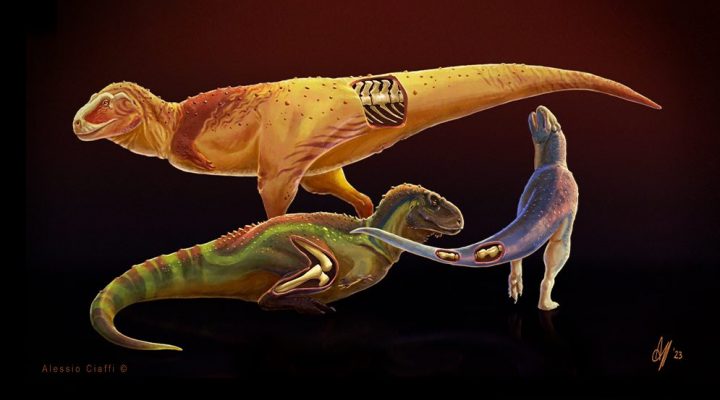EXACT AND NATURAL SCIENCES
Researchers identify diseases in predatory dinosaurs that lived in Patagonia at the end of the Cretaceous period
The study was conducted by CONICET palentologists.
CONICET scientists identified evidence of diseases in three species of abelisaurid dinosaurs that lived in Patagonia at the end of the Cretaceous period, approximately between 90 and 70 million years ago: Elemgasem nubilus, Aucasaurus garridoi and Quilmesaurus curriei. The abelisaurids were a family of bipedal carnivorous dinosaurs, characterized by having ornamented skull bones, greatly reduced forelimbs and a rigid axial skeleton due to peculiar joints in some vertebrae. The study, published in the journal BMC Ecology and Evolution, revealed new details about the health conditions of these majestic extinct reptiles.
During the first phase of the study, the scientists noticed deformations on the external surface of some bones at a macroscopic level, especially in the caudal vertebrae of specimens of Elemgasem and Aucasaurus. This finding led to the hypothesis of possible pathologies, which led the researchers to analyze both the external morphology and the internal structure of these specimens.
Three types of studies were carried out: the first consisted of the macroscopic analysis of the external structure of the bones; the second, of a histological type, focused on Quilmesaurus and Elemgasem, to examine changes at a microscopic level, both on the outside and inside of the bones; and the third included computed tomography scans on some elements of Aucasaurus, to evaluate how a possible pathology affected the bone tissue.
The results revealed three different types of pathologies. The Aucasaurus specimen had a congenital developmental disease, which indicated that this individual was born with a malformation that, despite this, allowed it to live for many years without serious effects. In the case of Elemgasem, spondyloarthropathy or spondyloarthritis was diagnosed, a disease also present in humans, which causes the fusion of vertebrae and the subsequent inflammation. The Quilmesaurus specimen, for its part, showed signs of some pathology that could not be determined precisely, but seemed different from those detected in the other two abelisaurids.
The last phase of the study consisted of the compilation and statistical analysis of all the diseases recorded in theropod dinosaurs worldwide, which allowed us to establish the most complete database to date for this group of extinct animals. One of the most important results was being able to establish, based on statistical analysis, correlations between some diseases and the lifestyle of these predators active in the past. Among other results, it was found that some groups of theropod dinosaurs, such as tyrannosaurids, presented bite marks with infections, which suggests that these predators had very aggressive intraspecific social behavior. In other cases, such as allosaurids, the high presence of fractures in the bones of the hind limbs would indicate an active lifestyle.
“This work not only expands our knowledge about the health of dinosaurs, but also highlights the presence of diseases that persist today, suggesting possible connections between the study of extinct organisms and research into contemporary diseases,” comments the first author of the study, Mattia Antonio Baiano, researcher at the Ernesto Bachmann Municipal Museum (Neuquén), who participated in the study within the framework of a CONICET postdoctoral fellowship.
“It is a very interesting work since it brings together specialties of different researchers and tries to discover a little of the marks left on the skeleton by the behavior of dinosaurs,” adds Diego Pol, CONICET researcher at the “Egidio Feruglio” Paleontological Museum (Chubut) and another of the authors of the study.
Also participating in the research were: Ignacio Cerda, CONICET researcher at the Institute for Research in Paleontology and Biology (IIPG), and Filippo Bertozzo, from the Royal Belgian Institute of Natural Sciences (Belgium).
The researchers highlight that studying dinosaur diseases could shed light on the origin of several current pathologies.
References:
Baiano, M.A., Cerda, I.A., Bertozzo, F. et al. New information on paleopathologies in non-avian theropod dinosaurs: a case study on South American abelisaurids. BMC Ecol Evo 24, 6 (2024). https://doi.org/10.1186/s12862-023-02187-x
By Martín Gasparini – Communication Area of Patagonia Confluencia
